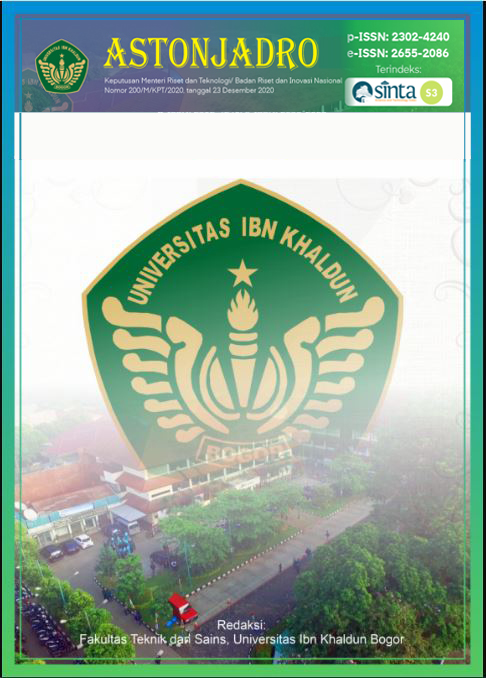Characteristics Study of Old Kampong Settlement in Batan Semarang City
DOI:
https://doi.org/10.32832/astonjadro.v11i3.7032Keywords:
characteristics of village, old kampong settlement, Batan, residential.Abstract
The development of urban areas occurs due to the demands for space for activities from the community. Increased activity in the city center has an impact on increasing the need for housing. Kampong Batan is one of the settlements located in the downtown triangle area of Pandanaran road, Pemuda road and Gajah Mada road (PANDAMA). Kampong Batan is also one of the old kampongs that experienced the growth of residential areas due to the development of activities. The implication of the development of activities in the city center to Kampong Batan is experiencing changes that are seen physically and non-physically. In this study, we will examine the characteristics of the Batan settlement in Semarang City in order to find out the changes that occur due to the development of activities in the city center. The research method used is field observation by looking at the development of Kampong Batan from the colonial era to the present based on the map of the previous year of Semarang City. Then it is identified the changes that occur based on the road network, changes in the use of residential space and the characteristics of the settlements. The result is that the settlement of Old Kampong Batan began to be filled with settlements from 1925 to 2000. The changes that are happening today can be seen from the expansion of residential activity space into a terrace, for parking and as a place to sell. In addition, many changes in the area that were previously only areas with residential functions have now turned into trade and service functions.
References
Arikunto, S., & Suhardjono, S. (2006). Penelitian tindakan kelas. Jakarta: Bumi Aksara.
Anak Agung Ngurah Aritama, Gede Windu Laskara, Made Wina Satria. (2022). Identification Of Green Architectural Characteristics Of Tenganan Pegringsingan Village, Karangasem, Bali. ASTONJADRO: CEAESJ 11 (2), 458-467.
Cobban, J. L. (1974). Uncontrolled Urban Settlement : the Kampong Question in Semarang (1905-1940). Bijdragen Tot De Taal-, Land- En Volkenkunde, 130(4), 403–427. https://www.jstor.org/stable/27861425
Hendro, E. P. (2016). Kampung-Kampung Bersejarah di Kota Semarang: Kajian Atas Nama Tempat. Sabda, 11(2), 34–52. https://ejournal.undip.ac.id/index.php/sabda/article/view/16045
Joe, L. T. (1931). Riwajat Semarang. Boekhandel Ho Kim Yoe.
Kotamadya Dati II Semarang. (1990). Peraturan Daerah Kotamadya Dati II Semarang No. 02 Tahun 1990 tentang Perubahan Pertama Perda Kotamadya Dati II Semarang No. 5 Tahun 1981 tentang Rencana Kota Semarang Tahun 1975-2000. Semarang.
Nugraha, A. (2007). Morfologi dan Tipologi Permukiman Kota Semarang Pasca Kemerdekaan (1950-1990). Universitas Katolik Soegijapranata. http://repository.unika.ac.id/17879/
Nursyahbani, R., & Pigawati, B. (2015). Kajian Karakteristik Kawasan Permukiman Kumuh di Kampung Kota (Studi Kasus: Kampung Gandekan Semarang). Jurnal Teknik PWK, 4(2), 267–281. https://ejournal3.undip.ac.id/index.php/pwk/article/view/8463
Purwanto, L.M. (2005). Kota Kolonial Lama Semarang (Tinjauan Umum Sejarah Perkembangan Arsitektur Kota). Dimensi Teknik Arsitektur,33(1),27–33. https://dimensi.petra.ac.id/index.php/ars/ article/view/16273
Rahardjo, T., Rahma, S., & Herwati, M. (2010). Kampung Jayengaten : The Emergence and Disappearance of a Kampung in Semarang. International Conference on the Urban Kampung, (January), 1–14. Surabaya.
Rybczynski, W., Bhatt, V., Alghandi, M., Bahannam, A., Niskier, M., & Pathare, B. (1984). How the Other Half Builds (1 ed.). Montreal.
Savitch, H. V. (2014). Post-Industrial Cities: Politics and Planning in New York, Paris, and London. Princeton University Press.
Theresiana, E., & Dewi, S. P. (2013). Analisis Perkembangan Struktur Ruang Kawasan Bersejarah Kampung Kauman Kota Semarang. Jurnal Teknik PWK, 2(3), 851–862. https://ejournal3.undip.ac.id/index.php/pwk/article/view/2951
Universiteit Leiden. (2020). Diambil dari Universiteit Leiden Libraries website: maps.library.leiden.edu
Zahnd, M. (2008). Model Baru Perancangan Kota yang Kontekstual. Yogyakarta: Kanisius.
Downloads
Published
How to Cite
Issue
Section
License
Copyright (c) 2022 ASTONJADRO: CEAESJ

This work is licensed under a Creative Commons Attribution-ShareAlike 4.0 International License.
Paper submitted to ASTONJADRO is the sole property of the Astonjadro Journal. Unless the author withdraws the paper because he does not want to be published in this journal. The publication rights are in the journal Astonjadro.ASTONJADRO
LICENSE
This work is licensed under a Creative Commons Attribution-ShareAlike 4.0 International License.
Based on a work at http://ejournal.uika-bogor.ac.id/index.php/ASTONJADRO













